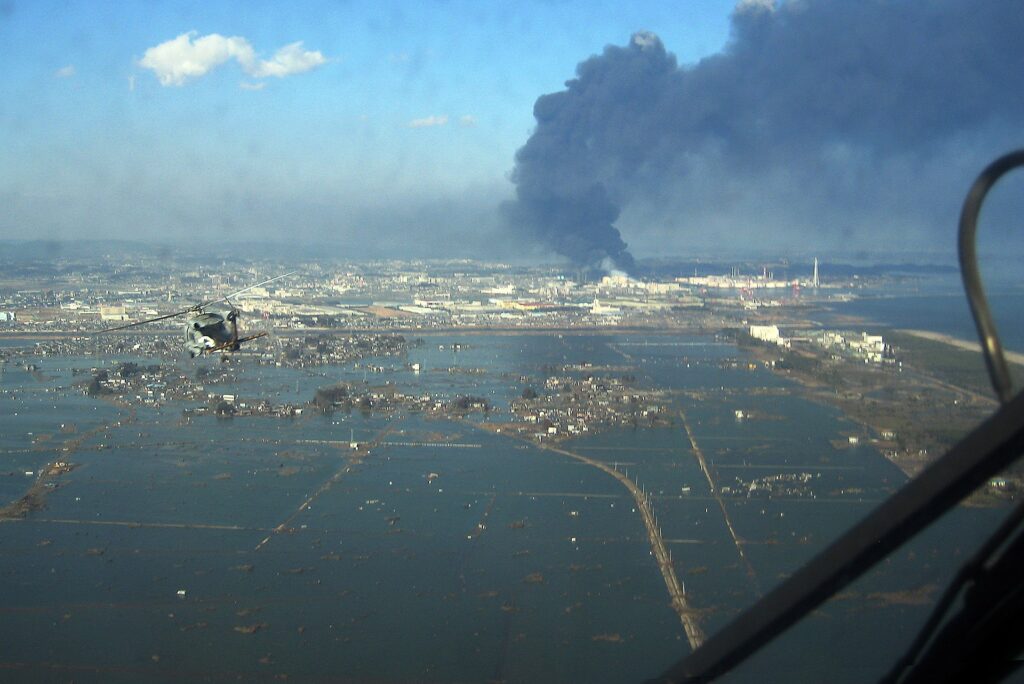On March 11, 2011, the Tohoku Earthquake, measuring 9.1 in magnitude, struck off the northeast coast of Honshu along the Japan Trench.
This event is also referred to as the Great Sendai Earthquake or the Great East Japan Earthquake and stands as the most powerful earthquake ever recorded in Japan.
The earthquake’s main shock triggered a tsunami that impacted a 2000-kilometer stretch of coastline, leading to extensive damage and the meltdown of three nuclear cores at the Fukushima Daiichi reactors, marking a major nuclear incident.

The impact of the Tohoku Earthquake
The impact of the massive earthquake, the most powerful in Japan’s history, resonated globally, affecting regions from the fjords of Norway to the ice sheets of Antarctica. Debris from the tsunami has been found on North American shores even years after the event.
In Japan, the process of recovery from the catastrophe is ongoing. As of November 2021, approximately 39,000 people were still displaced, with about 1,000 of them residing in temporary accommodations, as reported by Japan’s Reconstruction Agency.
The disaster led to the destruction of over 120,000 buildings, with another 278,000 severely damaged and 726,000 partially damaged, according to the agency.
The Japanese government estimates the direct financial losses from the disaster at around $199 billion (approximately 16.9 trillion yen). The World Bank’s estimates suggest that the total economic impact could rise to as much as $235 billion, potentially making it the most expensive natural disaster in recorded history.
Thousands lost their lives
As of December 2021, the official count of people who lost their lives stands at 19,747, based on figures from the reconstruction agency. Additionally, over 2,500 individuals are still listed as missing.
Within an hour of the earthquake’s occurrence, the initial tsunami waves began striking the coast of Japan. These waves reached run-up heights of up to 128 feet (39 meters) in Miyako city and penetrated as far as 6 miles (10 kilometers) inland in Sendai.
The National Oceanic and Atmospheric Administration reports that the tsunami inundated an estimated area of around 217 square miles (561 square kilometers) within Japan.
The force of the waves was so powerful that they overcame and demolished several tsunami seawalls designed for coastal protection. In some areas, even three-story buildings, where people had sought refuge, were destroyed by the surge.
Near Oarai, the tsunami created a massive whirlpool offshore, an event that was recorded on video.
Fukushima nuclear accident
The earthquake triggered the nuclear plant’s systems to detect the seismic activity and automatically shut down the reactors. Following the shutdown, emergency diesel generators activated to continue circulating coolant around the cores, which remain extremely hot even after shutdown.
However, the situation escalated when a tsunami wave exceeding 14 meters (46 feet) struck Fukushima. The wave breached the protective sea wall and flooded the plant, disabling the emergency generators.
This led to nuclear meltdowns and several hydrogen explosions. Efforts to restore power were immediate, but in the ensuing days, the nuclear fuel in three reactors overheated, leading to partial melting of the cores, a scenario known as a nuclear meltdown.
Additionally, the plant experienced several chemical explosions, causing significant damage to its structures. Radioactive materials began to leak into the atmosphere and the Pacific Ocean. This resulted in evacuations and the establishment of an expanding exclusion zone, leading to over 150,000 people being evacuated from the vicinity.
More than ten years later, this exclusion zone is still enforced, with many residents yet to return. The cleanup and decontamination efforts are projected to take up to 40 years, costing Japan trillions of yen.
The Fukushima Disaster has been designated as a level seven event by the International Atomic Energy Agency, the most severe rating. It is only the second incident to be classified at this level, following the 1986 Chernobyl disaster.
Japanese Government Response to the earthquake
Following the tsunami, Japan’s Meteorological Agency faced criticism for its initial tsunami warning, which underestimated the wave’s magnitude. A study by the Japanese government, published in August 2011, revealed that in areas like Miyagi and Fukushima, only about 58% of people sought higher ground immediately after the earthquake.
The study also found that many individuals either downplayed their personal risk or expected the tsunami to be similar to smaller ones they had experienced before.
Post-disaster, scientists from across the globe converged in Japan to conduct extensive research. Researchers embarked on offshore expeditions, deploying sensors along the fault line to analyze the forces behind the earthquake.
Teams also investigated tsunami deposits to gain insights into the ancient sedimentary records of these destructive waves. Earthquake engineers scrutinized the damage, searching for ways to enhance building resilience against earthquakes and tsunamis.
The Effects Worldwide
The tsunami waves generated by the earthquake extended across the Pacific Ocean, impacting regions such as Alaska, Hawaii, and Chile. In Chile, over 11,000 miles (17,000 km) away, the tsunami waves measured approximately 6.6 feet (2 meters) in height upon reaching the coastline, as reported by the Pacific Tsunami Warning Center.
An estimated 5 million tons of debris were swept into the ocean, according to the National Oceanic and Atmospheric Agency.
This debris included Japanese docks, ships, and various household items, many of which have washed up on the shores of the United States and Canada in the years following the tsunami. In 2012, the U.S. Coast Guard targeted and sank the abandoned 164-foot vessel Ryou-Un Maru in the Gulf of Alaska, a ship that had begun its voyage in Hokkaido, Japan.

